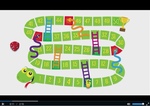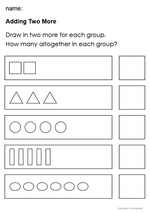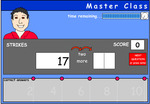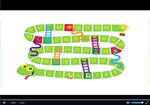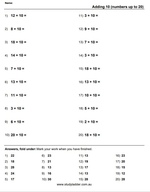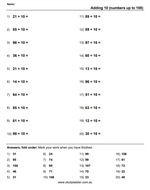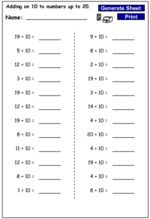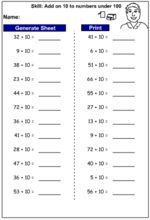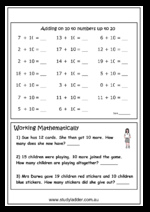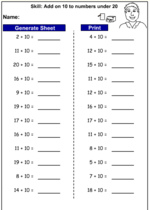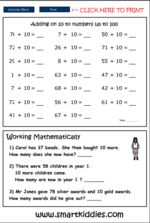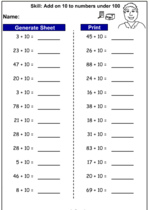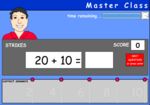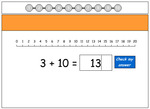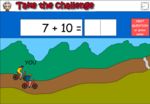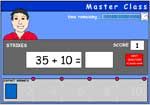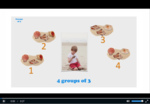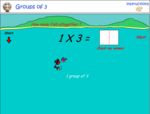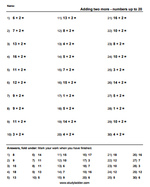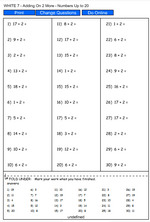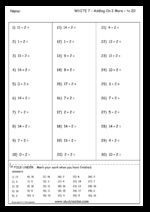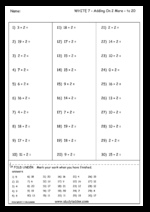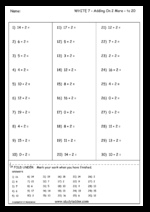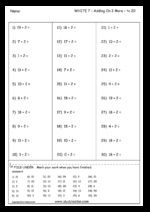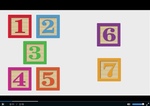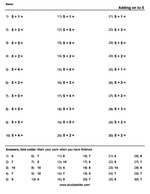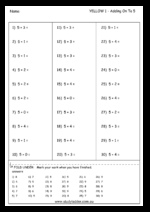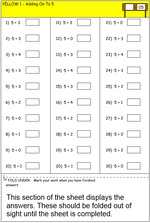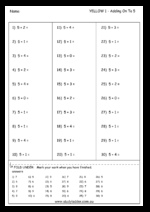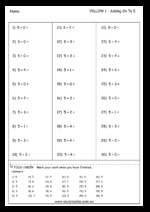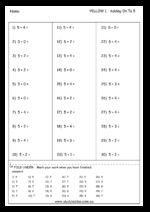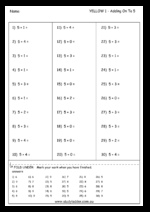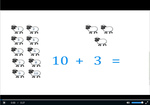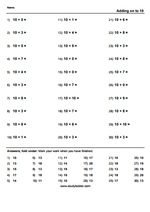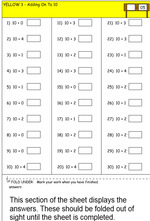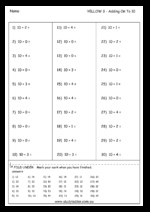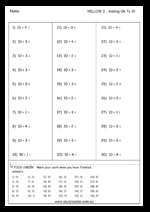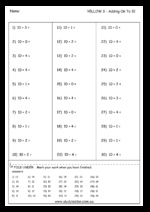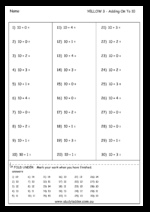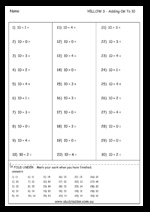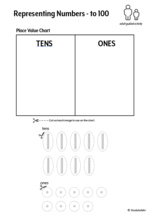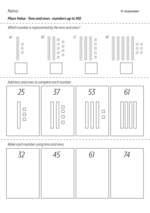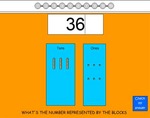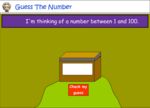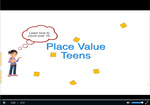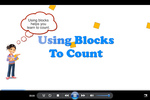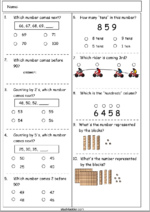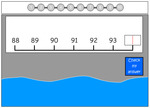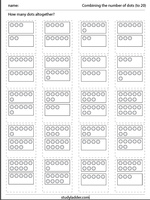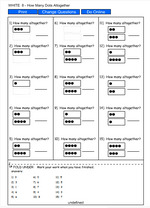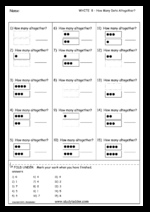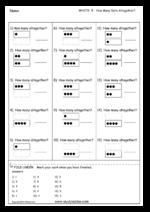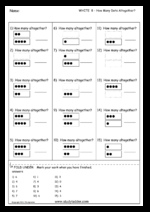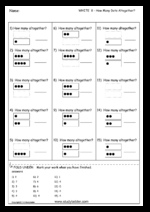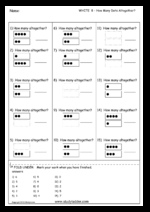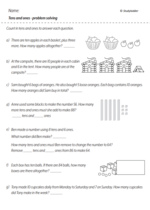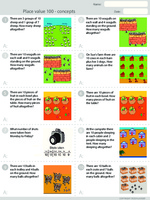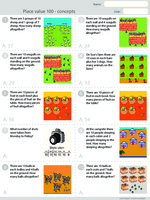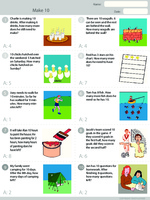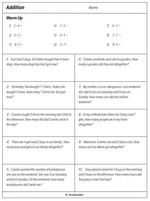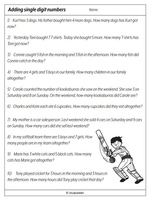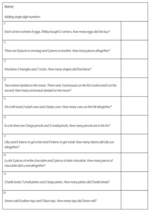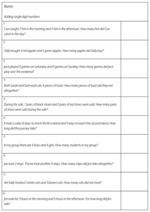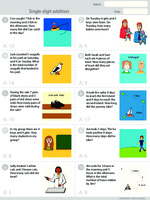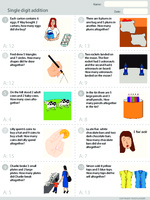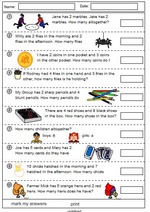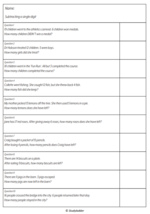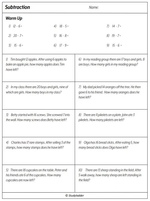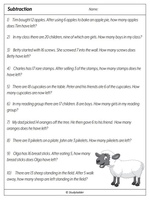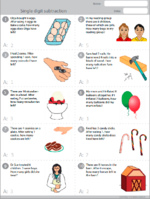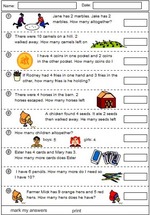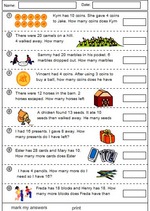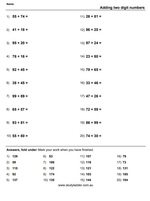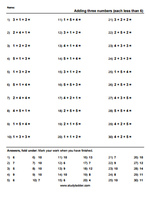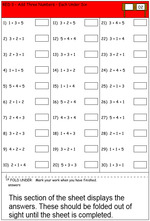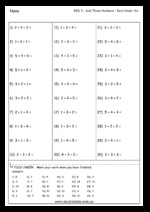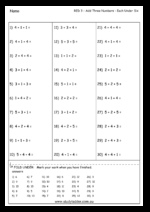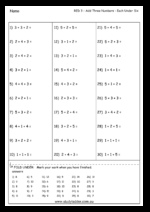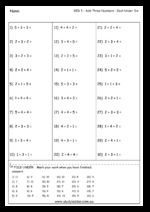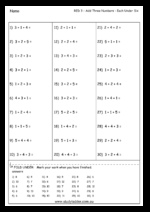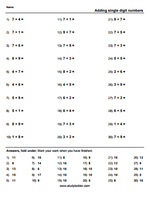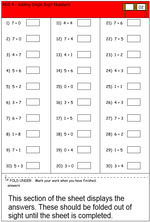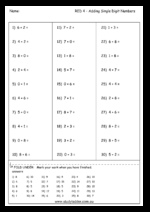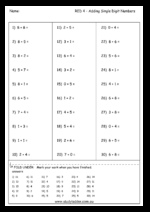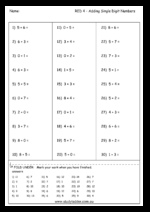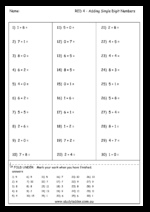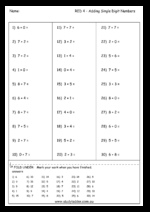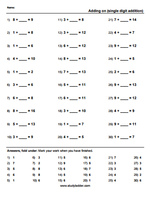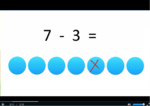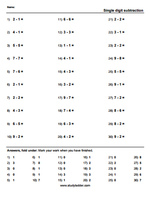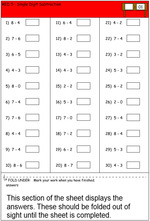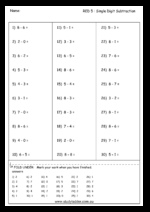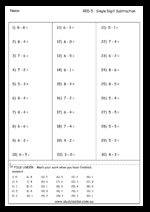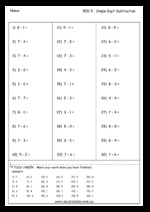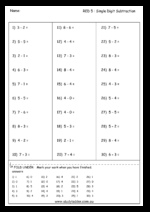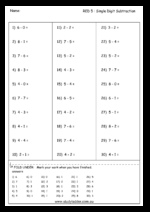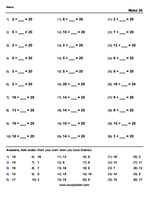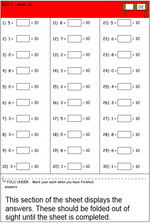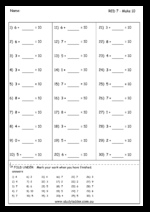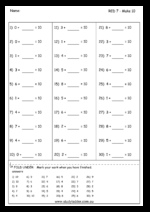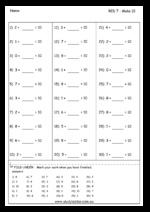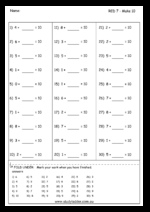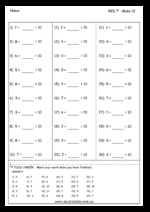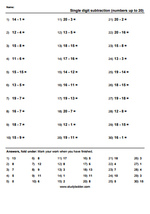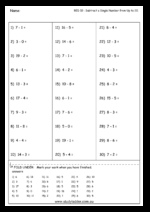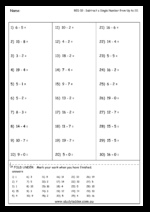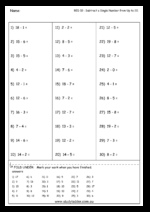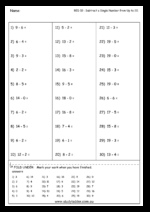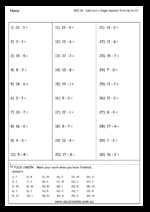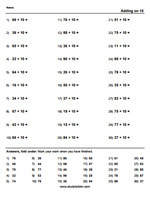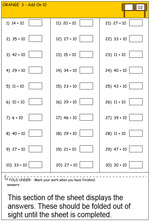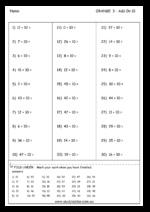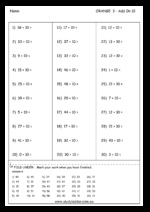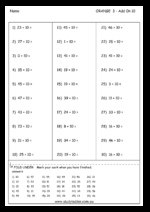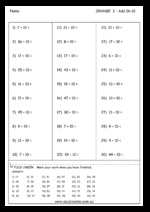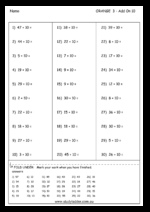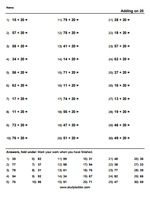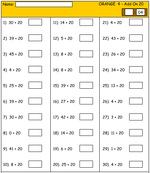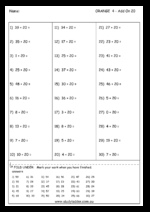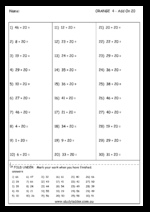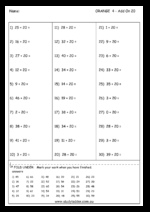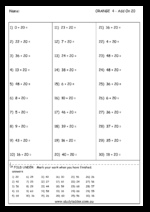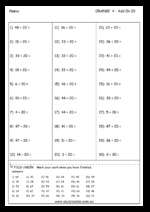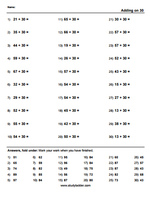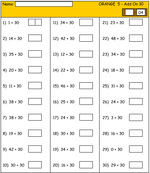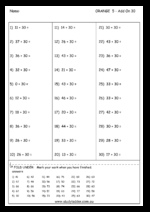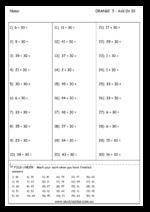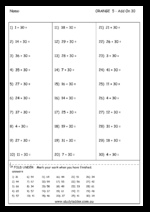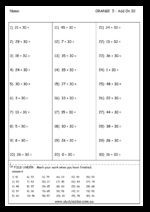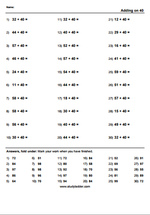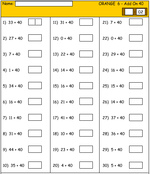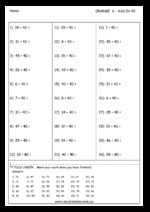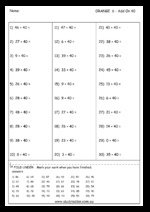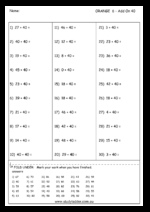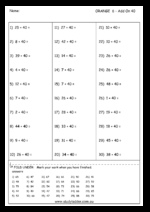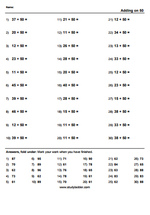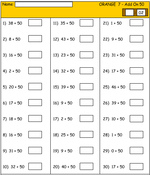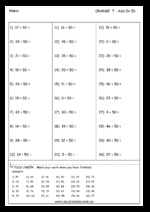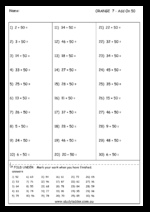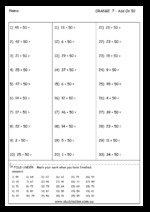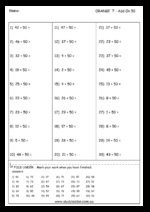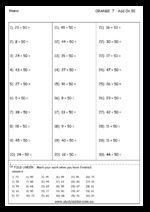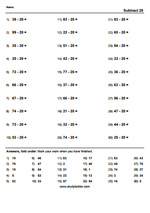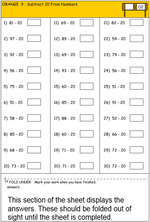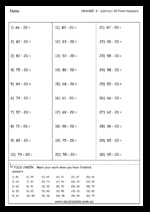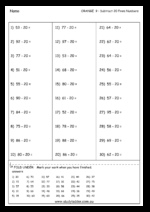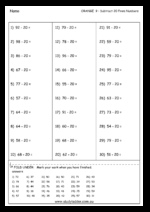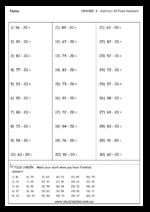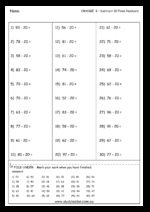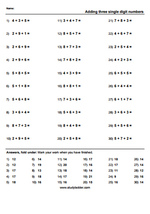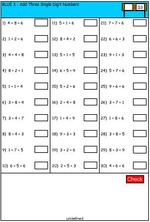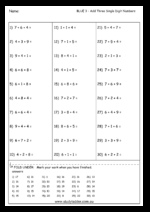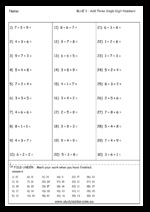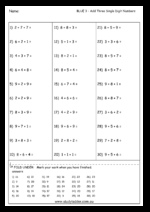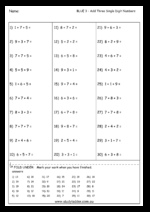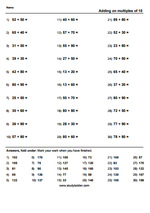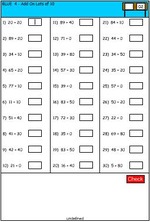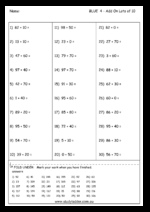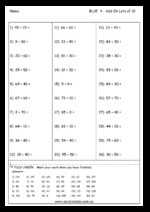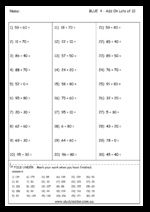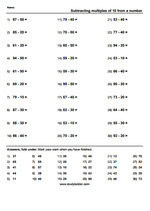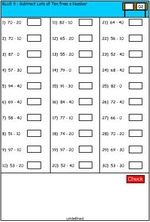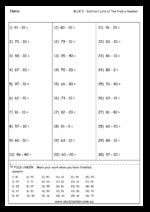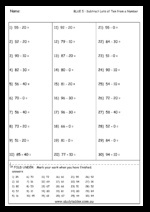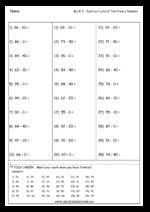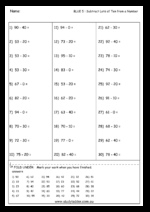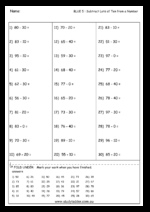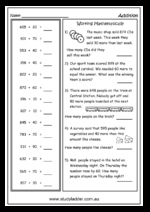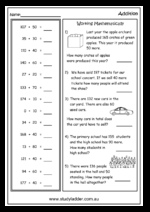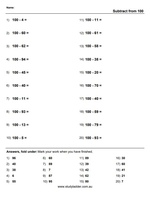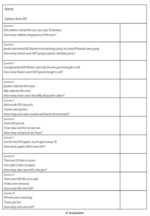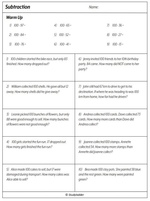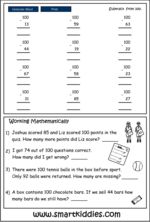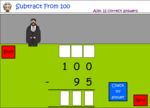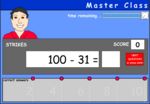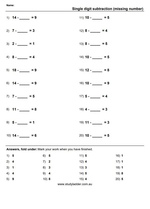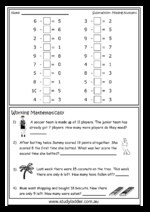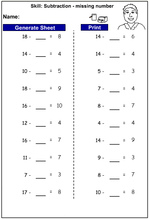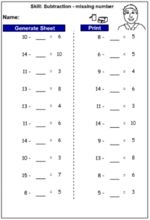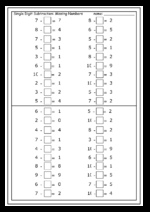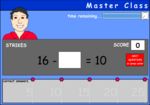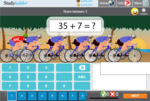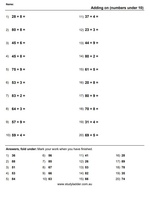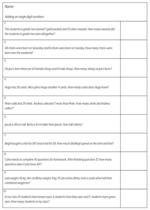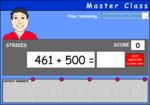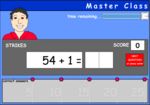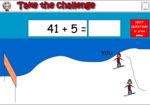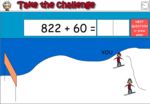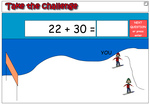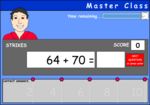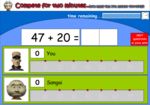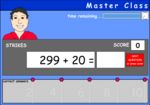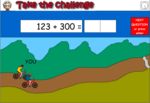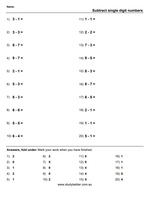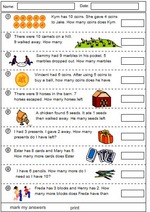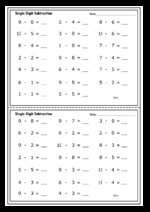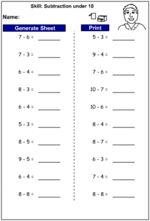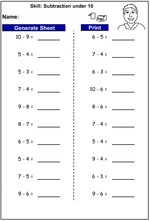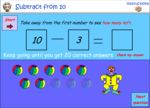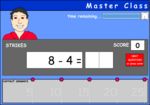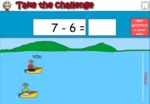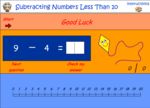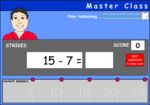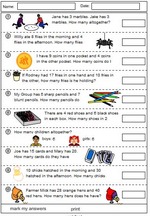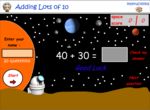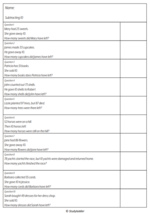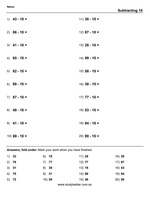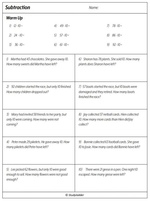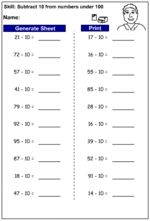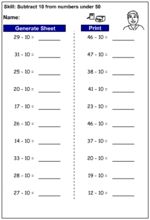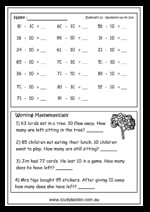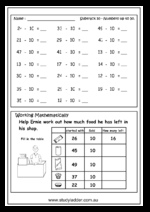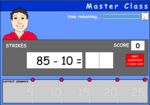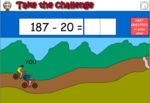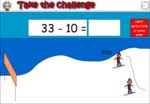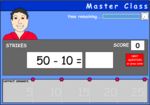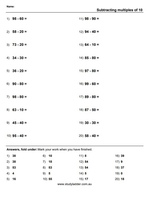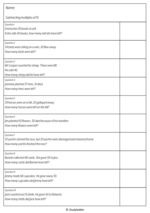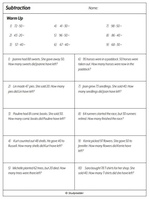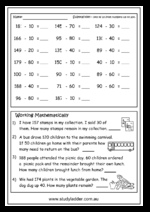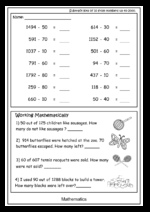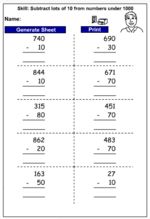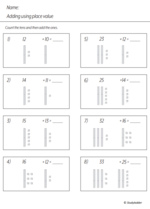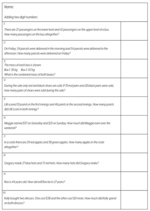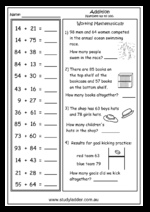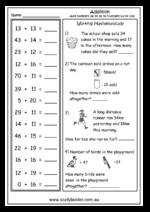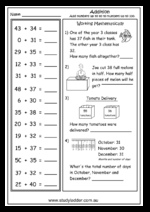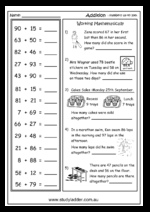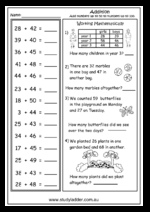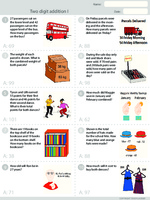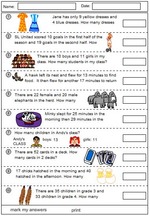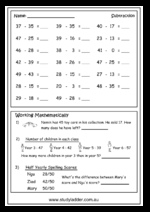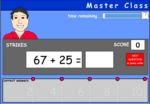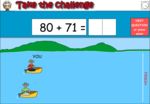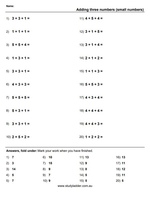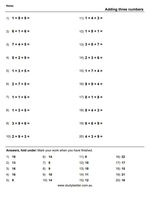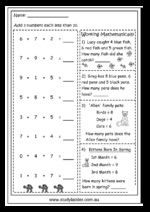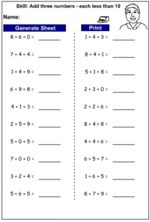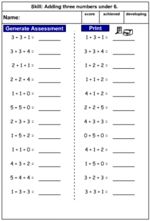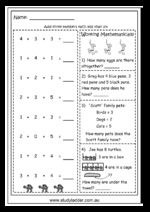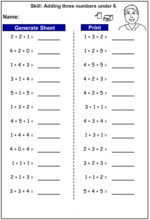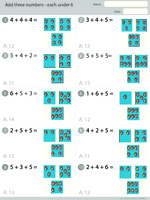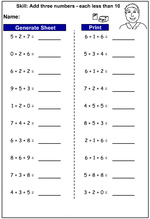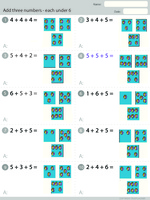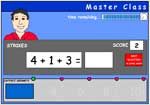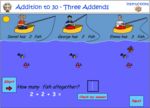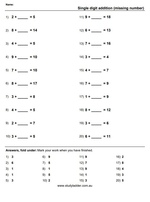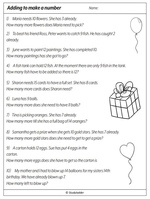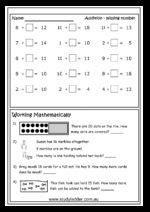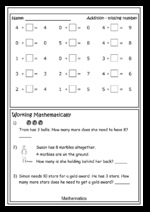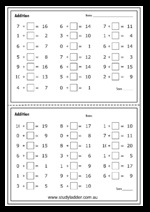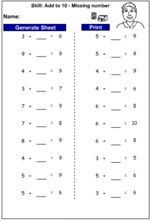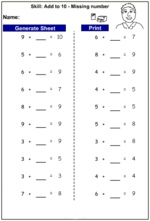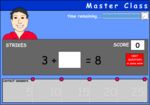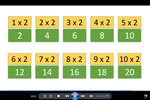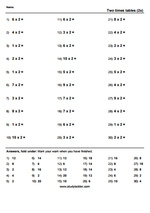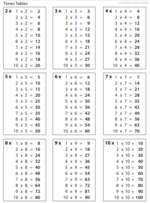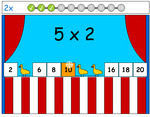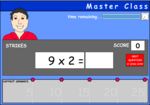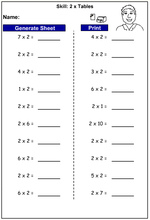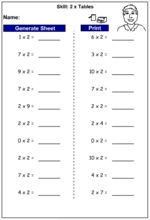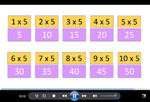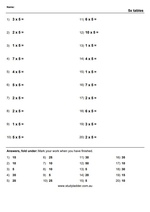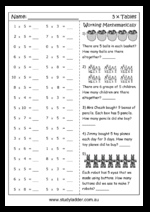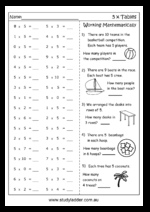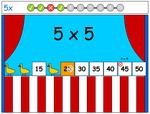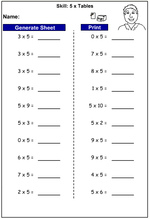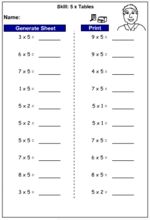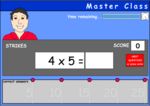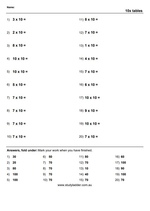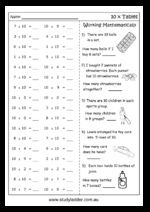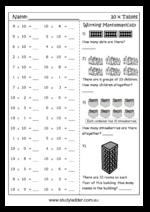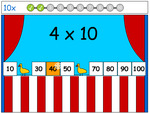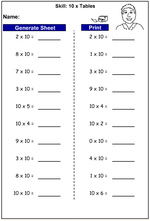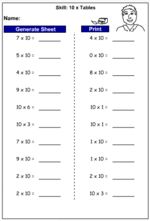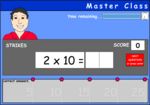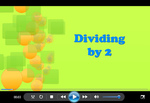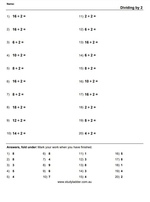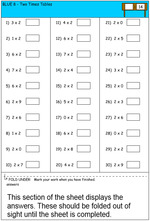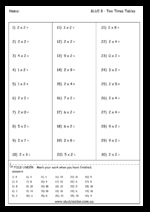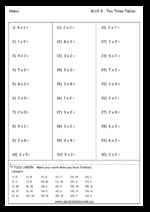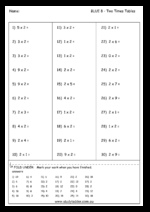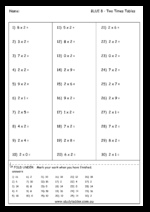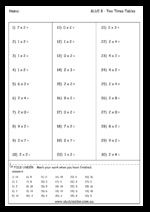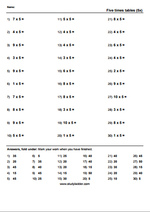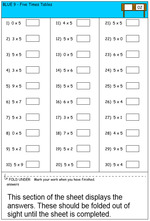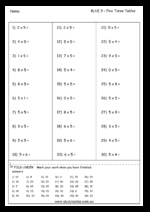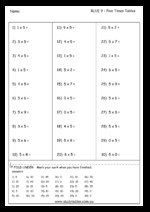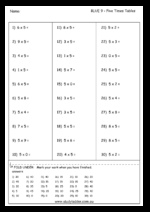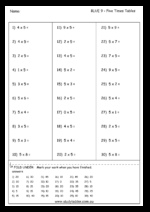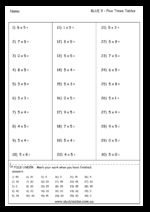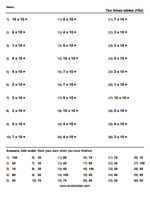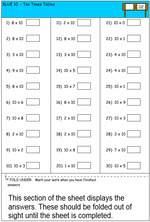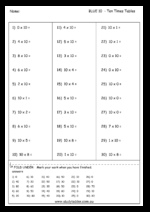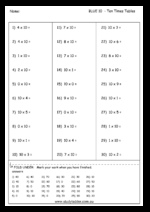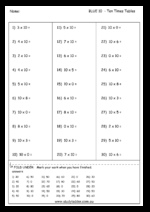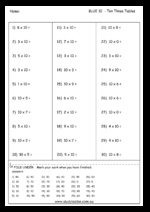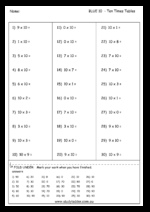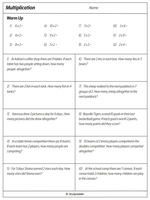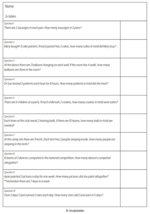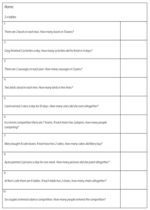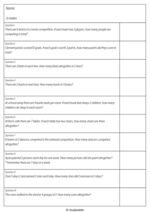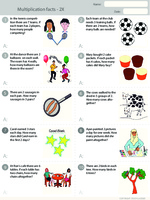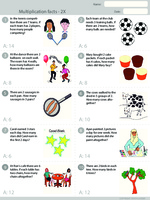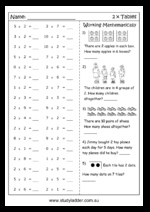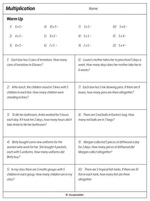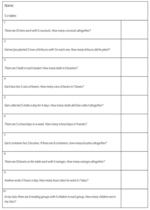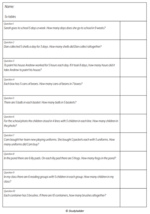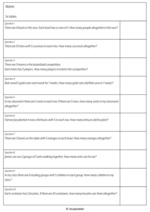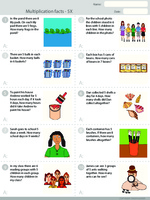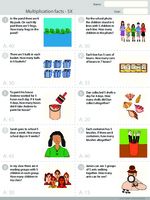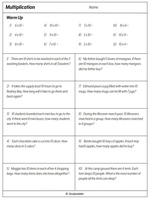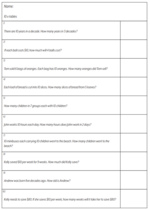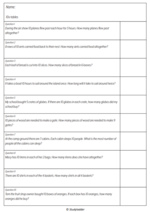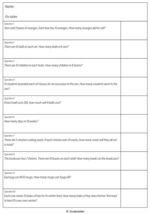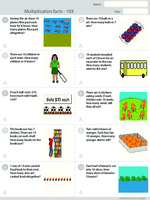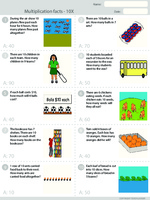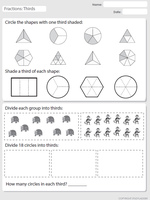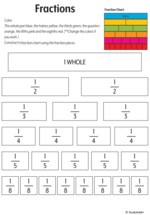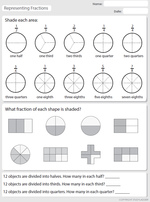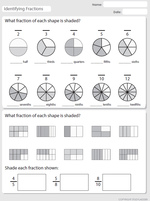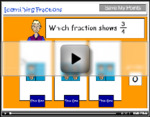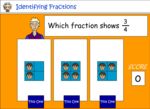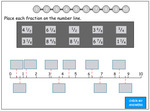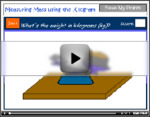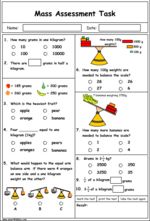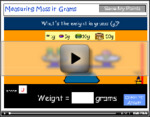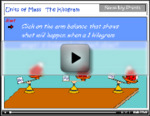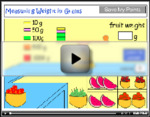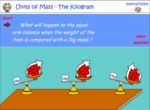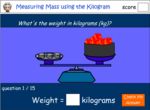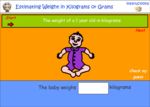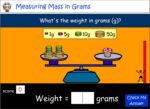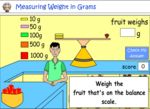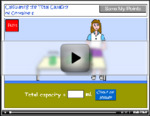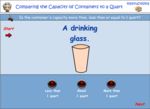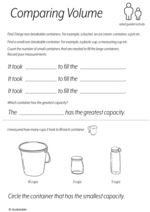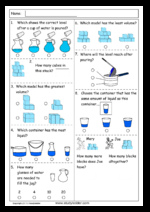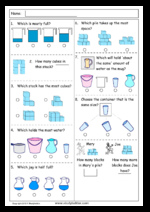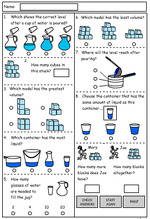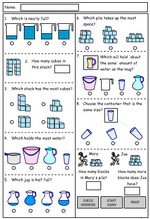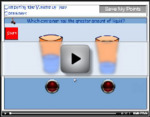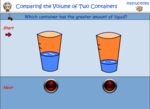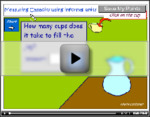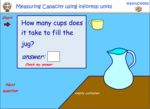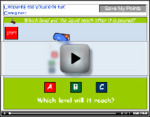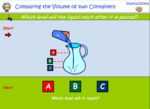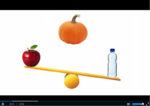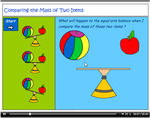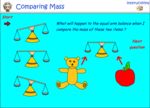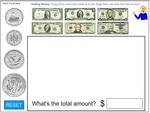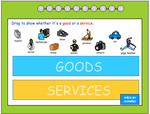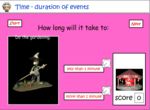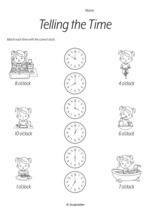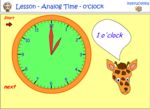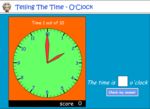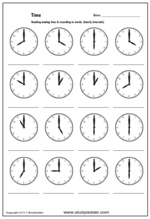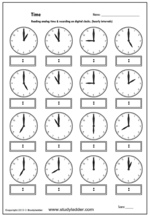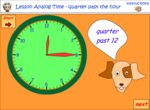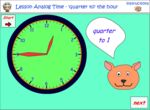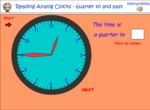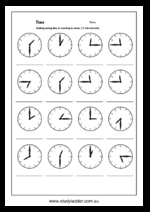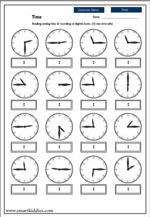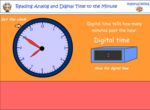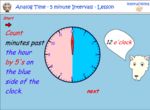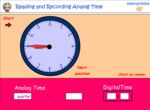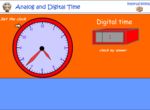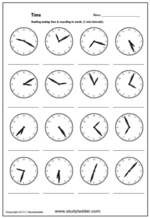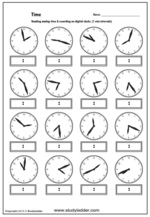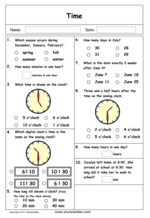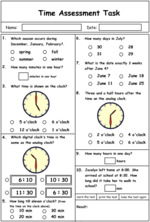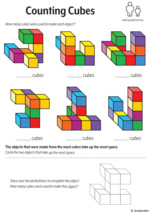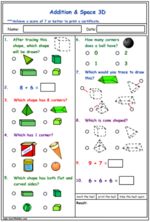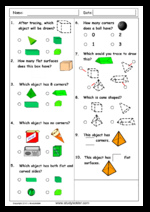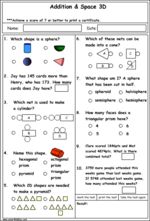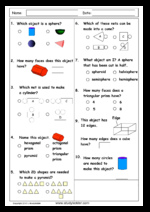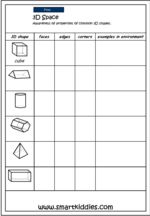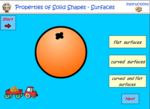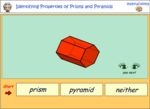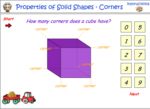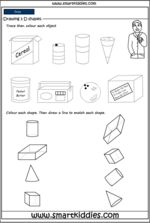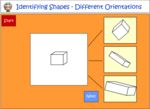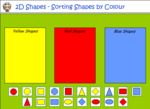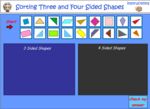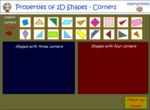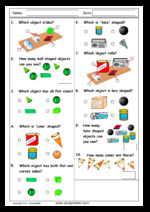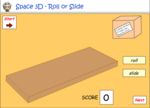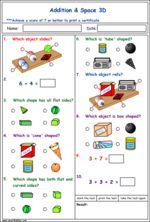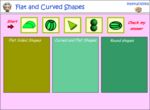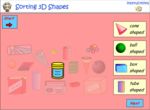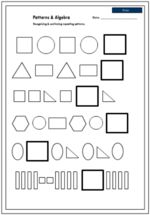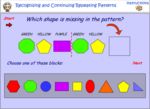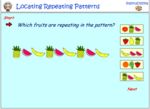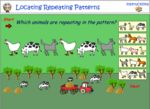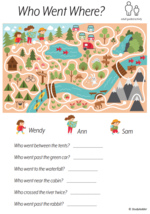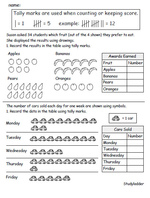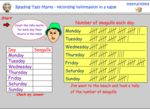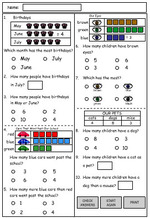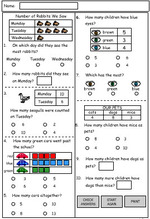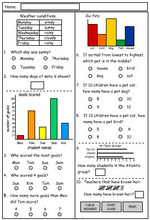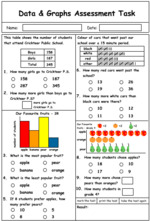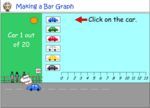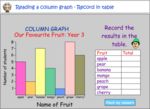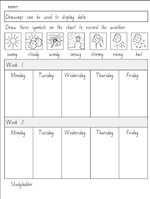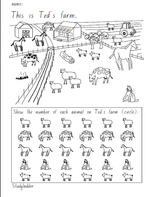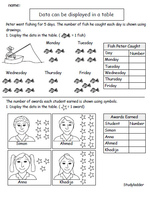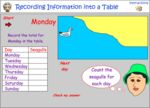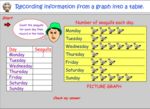Mathematics – United Kingdom – National Curriculum
Year 2 programme of study
KS1.Y2.N.NPV – Number - number and place value
Pupils should be taught to:
KS1.Y2.N.NPV.1 – Count in steps of 2, 3, and 5 from 0, and in 10s from any number, forward and backward
-
9 learning outcomes – click to view
Samples: Two more than. Adding 2 (number line). Adding 10. Adding on 10 using blocks. Adding multiples of 10 using blocks.
-
Two more than
- Activities: 4 course, 5 extra
-
-
- Two more than
- Tutorial
-
-
-
- Two more than
- Practice
-
-
-
- Two more than - number line
- Practice
-
-
-
- Two more than - problem solving
- Practice
-
Extra activities
-
-
- Two more than
- Printable
-
-
-
- Count on 2 - numbers up to 10
- Tutorial
-
-
-
- Count on 2 - numbers up to 10
- Tutorial
-
-
-

- Count on 2 - numbers up to 20
- Assessment
-
-
-
- Count on 2 - numbers up to 10
- Tutorial
-
-
Adding two more on a number line
- Activities: 2 course, 0 extra
-
-
- Adding 2 (number line)
- Challenge
-
-
-
- ONE MINUTE CHALLENGE - Add 2
- Challenge
-
-
Adding 10 to two-digit numbers
- Activities: 6 course, 14 extra
-
-
- Adding 10
- Tutorial
-
-
-
- Adding 10
- Tutorial
-
-
-
- Adding on 10 using blocks
- Practice
-
-
-
- Adding 10 to numbers up to 100
- Practice
-
-
-
- Adding 10 (to two digits)
- Challenge
-
-
-
- Counting Forwards By 10
- Tutorial
-
Extra activities
-
-
- Adding 10 (numbers up to 20)
- Printable
-
-
-
- Adding 10 (numbers up to 100)
- Printable
-
-
-
- Drill - add on 10 to numbers up to 20
- Printable
-
-
-
- Drill Add On 10 to numbers Less 100
- Printable
-
-
-

- Add on 10 - Jump Strategy
- Practice
-
-
Place value - adding 10
- Activities: 2 course, 0 extra
-
-
- Adding on 10 using blocks
- Tutorial
-
-
-
- Adding on 10 using blocks
- Practice
-
-
Place value - adding multiples of 10
- Activities: 2 course, 0 extra
-
-
- Adding multiples of 10 using blocks
- Tutorial
-
-
-
- Adding multiples of 10 using blocks
- Practice
-
-
Number patterns and groups (of 3)
- Activities: 3 course, 1 extra
-
-
- Groups of 3
- Tutorial
-
-
-
- Rows of 3
- Tutorial
-
-
-
- Groups of 3
- Practice
-
Extra activities
-
-

- Groups of three
- Practice
-
-
Adding 2 more - numbers to 20 (Skill 6)
- Activities: 5 course, 7 extra
-
-
- Count on 2 - numbers up to 10
- Tutorial
-
-
-
- Adding two more - numbers up to 20
- Practice
-
-
-
- Adding two more - numbers up to 20
- Practice
-
-
-
- Adding two more - numbers up to 20
- Practice
-
-
-
- Adding two more - numbers up to 20
- Assessment Practice
-
Extra activities
-
-
- Adding two more - numbers up to 20
- Printable
-
-
-

- 7: Adding On Two More Up To 20
- Printable
-
-
-
- white 7 sheet 1
- Printable
-
-
-
- white 7 sheet 2
- Printable
-
-
-
- white 7 sheet 3
- Printable
-
-
-
- white 7 sheet 4
- Printable
-
-
-
- white 7 sheet 5
- Printable
-
-
Adding on to 5 (Skill 8)
- Activities: 5 course, 7 extra
-
-
- Add on to 5
- Tutorial
-
-
-
- Adding onto 5
- Practice
-
-
-
- Adding onto 5
- Practice
-
-
-
- Adding onto 5
- Practice
-
-
-
- Adding onto 5
- Assessment Practice
-
Extra activities
-
-
- Adding on to 5
- Printable
-
-
-
- Adding on to Five
- Printable
-
-
-

- Adding Onto Five
- Printable
-
-
-
- yellow 1 sheet 2
- Printable
-
-
-
- yellow 1 sheet 3
- Printable
-
-
-
- yellow 1 sheet 4
- Printable
-
-
-
- yellow 1 sheet 5
- Printable
-
-
Adding on to 10 (Skill 9)
- Activities: 6 course, 7 extra
-
-
- Ten Frames - 10 plus ones
- Tutorial
-
-
-
- Add on to 10
- Tutorial
-
-
-
- Adding on to 10
- Practice
-
-
-
- Adding on to 10
- Practice
-
-
-
- Adding on to 10
- Practice
-
-
-
- Adding on to 10
- Assessment Practice
-
Extra activities
-
-
- Adding on to 10
- Printable
-
-
-

- Adding On To 10
- Printable
-
-
-
- yellow 3 sheet 1
- Printable
-
-
-
- yellow 3 sheet 2
- Printable
-
-
-
- yellow 3 sheet 3
- Printable
-
-
-
- yellow 3 sheet 4
- Printable
-
-
-
- yellow 3 sheet 5
- Printable
-
-
-
9 learning outcomes – click to view
KS1.Y2.N.NPV.2 – Recognise the place value of each digit in a two-digit number (10s, 1s)
-
2 learning outcomes – click to view
Samples: Representing numbers using tens and ones (11-100). Place Values teens: counting 15 sticks.
-
Place value - tens and ones (to 100)
- Activities: 8 course, 3 extra
-
-
- Representing place value - to 100
- Printable
-
-
-
- Place Values
- Tutorial
-
-
-
- Place Values
- Tutorial
-
Extra activities
-
-
- Tens and ones - numbers up to 100
- Printable
-
-
-

- Identifying Place Value
- Practice
-
-
-

- Guessing game - Numbers to 100
- Practice
-
-
-
2 learning outcomes – click to view
KS1.Y2.N.NPV.3 – Identify, represent and estimate numbers using different representations, including the number line
-
7 learning outcomes – click to view
Samples: Odd or Even amounts. Even numbers to 20 - equations. Place Value Teens Mab using blocks to count.
-
Place value (11-20)
- Activities: 2 course, 0 extra
-
Counting to one hundred on a number line
- Activities: 3 course, 2 extra
-
-
- Counting to 100 (number line 30-50)
- Practice
-
-
-
- Counting to 100 (number line 50-70)
- Practice
-
-
-
- Counting to 100 (number line 70-100)
- Practice
-
Extra activities
-
-
- Numbers Problem Solving
- Printable
-
-
-

- Count to 100
- Practice
-
-
Combining the number of dots (Skill 7)
- Activities: 5 course, 8 extra
-
-
- The Plus symbol
- Tutorial
-
-
-
- Counting (Subitising)
- Practice
-
-
-
- Combining the number of dots
- Practice
-
-
-
- Combining the number of dots - to 20
- Practice
-
-
-
- Combining the number of dots (1-20)
- Assessment Practice
-
Extra activities
-
-
- Combining the number of dots
- Printable
-
-
-
- Combining the number of dots
- Practice Printable
-
-
-

- 8: Combining The Number Of Dots
- Printable
-
-
-
- white 8 sheet 1
- Printable
-
-
-
- white 8 sheet 2
- Printable
-
-
-
- white 8 sheet 3
- Printable
-
-
-
- white 8 sheet 4
- Printable
-
-
-
- white 8 sheet 5
- Printable
-
-
7 learning outcomes – click to view
KS1.Y2.N.NPV.4 – Compare and order numbers from 0 up to 100; use <, > and = signs
KS1.Y2.N.NPV.5 – Read and write numbers to at least 100 in numerals and in words
KS1.Y2.N.NPV.6 – Use place value and number facts to solve problems
-
1 learning outcomes – click to view
Samples: Place value concepts (bundled sticks). Counting in tens and ones. Place value 100. Counting in tens and ones.
-
Counting in tens and ones
- Activities: 3 course, 3 extra
-
-
- Counting in tens and ones
- Practice
-
-
-
- Place value 100
- Practice
-
Extra activities
-
-
- Counting in tens and ones
- Printable
-
-
-
- Place value 100 concepts
- Printable
-
-
-
- Place value 100 - concepts Answer sheet
- Printable
-
-
-
1 learning outcomes – click to view
KS1.Y2.N.AS – Number - addition and subtraction
Pupils should be taught to:
KS1.Y2.N.AS.1 – Solve problems with addition and subtraction:
KS1.Y2.N.AS.1.a: using concrete objects and pictorial representations, including those involving numbers, quantities and measures
-
3 learning outcomes – click to view
Samples: Make 10 (problem solving). Adding single digit numbers (problem solving).
-
Make 10 (problem solving)
- Activities: 2 course, 2 extra
-
-
- Make 10 (problem solving)
- Practice
-
-
-
- Make 10 (problem solving)
- Practice
-
Extra activities
-
-
- Make 10 (problem solving)
- Printable
-
-
-
- Make 10 (problem solving) Answer sheet
- Printable
-
-
Adding single-digit numbers- problem solving
- Activities: 4 course, 9 extra
-
Subtracting single digits from up to 20 (problem solving)
- Activities: 2 course, 7 extra
-
-
- Single digit subtraction
- Practice
-
Extra activities
-
-
- Single digit subtraction
- Printable
-
-
-
- Single digit subtraction Answer sheet
- Printable
-
-
-

- Addition and subtraction problem solving
- Assessment
-
-
-

- Subtraction problem solving
- Assessment
-
-
-
3 learning outcomes – click to view
KS1.Y2.N.AS.1.b: applying their increasing knowledge of mental and written methods
-
17 learning outcomes – click to view
Samples: Adding two digit numbers (look for 10). Adding two digit numbers. Add three numbers - each under 6.
-
Adding two digit numbers
- Activities: 2 course, 1 extra
-
-
- Adding two digit numbers
- Practice
-
-
-
- Adding two digit numbers
- Practice
-
Extra activities
-
-
- Adding two digit numbers
- Printable
-
-
Adding 3 numbers - each less than 6 (Skill 15)
- Activities: 5 course, 7 extra
-
-
- Add three numbers - each under 6
- Tutorial
-
-
-
- Adding three numbers (each less than 6)
- Assessment Practice
-
Extra activities
-
-
- Adding three numbers (each less than 6)
- Printable
-
-
-

- Add Three Numbers Each Less Than Six
- Printable
-
-
-
- red 3 sheet 1
- Printable
-
-
-
- red 3 sheet 2
- Printable
-
-
-
- red 3 sheet 3
- Printable
-
-
-
- red 3 sheet 4
- Printable
-
-
-
- red 3 sheet 5
- Printable
-
-
Adding single digit numbers (Skill 16)
- Activities: 6 course, 7 extra
-
-
- Adding on a number line
- Tutorial
-
-
-
- Add numbers less than 5
- Tutorial
-
-
-
- Adding single digit numbers
- Practice
-
-
-
- Adding single digit numbers
- Practice
-
-
-
- Adding single digit numbers
- Practice
-
-
-
- Adding single digit numbers
- Assessment Practice
-
Extra activities
-
-
- Adding single digit numbers
- Printable
-
-
-

- Adding Single Digit Numbers
- Printable
-
-
-
- red 4 sheet 1
- Printable
-
-
-
- red 4 sheet 2
- Printable
-
-
-
- red 4 sheet 3
- Printable
-
-
-
- red 4 sheet 4
- Printable
-
-
-
- red 4 sheet 5
- Printable
-
-
Adding on - single digit addition (Skill 18)
- Activities: 5 course, 1 extra
-
-
- Adding on (single digit addition)
- Practice
-
-
-
- Adding on (single digit addition)
- Practice
-
-
-
- Adding on (single digit addition)
- Practice
-
-
-
- Adding on (single digit addition)
- Assessment Practice
-
Extra activities
-
-
- Adding on (single digit addition)
- Printable
-
-
Single digit subtraction (Skill 19)
- Activities: 6 course, 7 extra
-
-
- Subtraction using counters
- Tutorial
-
-
-
- Subtraction symbol
- Tutorial
-
-
-
- Single digit subtraction
- Practice
-
-
-
- Single digit subtraction
- Practice
-
-
-
- Single digit subtraction
- Practice
-
-
-
- Single digit subtraction
- Assessment Practice
-
Extra activities
-
-
- Single digit subtraction
- Printable
-
-
-

- Single Digit Subtraction
- Printable
-
-
-
- red 5 sheet 1
- Printable
-
-
-
- red 5 sheet 2
- Printable
-
-
-
- red 5 sheet 3
- Printable
-
-
-
- red 5 sheet 4
- Printable
-
-
-
- red 5 sheet 5
- Printable
-
-
Make 20 (Skill 20)
- Activities: 5 course, 7 extra
Extra activities
-
-
- Make 20
- Printable
-
-
-

- Make Ten
- Printable
-
-
-
- red 7 sheet 1
- Printable
-
-
-
- red 7 sheet 2
- Printable
-
-
-
- red 7 sheet 3
- Printable
-
-
-
- red 7 sheet 4
- Printable
-
-
-
- red 7 sheet 5
- Printable
-
-
Single digit subtraction up to 20 (Skill 21)
- Activities: 4 course, 7 extra
-
-
- Single digit subtraction (numbers up to 20)
- Assessment Practice
-
Extra activities
-
-

- Single Digit Subtraction From Up To 20
- Printable
-
-
-
- red 10 sheet 1
- Printable
-
-
-
- red 10 sheet 2
- Printable
-
-
-
- red 10 sheet 3
- Printable
-
-
-
- red 10 sheet 4
- Printable
-
-
-
- red 10 sheet 5
- Printable
-
-
Adding on 10 (Skill 22)
- Activities: 5 course, 7 extra
-
-
- Adding 10
- Tutorial
-
-
-
- Adding on 10
- Practice
-
-
-
- Adding on 10
- Practice
-
-
-
- Adding on 10
- Practice
-
-
-
- Adding on 10
- Assessment Practice
-
Extra activities
-
-
- Adding on 10
- Printable
-
-
-

- Add On 10
- Printable
-
-
-
- orange 3 sheet 1
- Printable
-
-
-
- orange 3 sheet 2
- Printable
-
-
-
- orange 3 sheet 3
- Printable
-
-
-
- orange 3 sheet 4
- Printable
-
-
-
- orange 3 sheet 5
- Printable
-
-
Adding on 20 (Skill 23)
- Activities: 5 course, 7 extra
-
-
- Adding multiples of 10
- Tutorial
-
-
-
- Adding on 20
- Practice
-
-
-
- Adding on 20
- Practice
-
-
-
- Adding on 20
- Practice
-
-
-
- Adding on 20
- Assessment Practice
-
Extra activities
-
-
- Adding on 20
- Printable
-
-
-

- Add On 20
- Printable
-
-
-
- orange 4 sheet 1
- Printable
-
-
-
- orange 4 sheet 2
- Printable
-
-
-
- orange 4 sheet 3
- Printable
-
-
-
- orange 4 sheet 4
- Printable
-
-
-
- orange 4 sheet 5
- Printable
-
-
Adding on 30 (Skill 24)
- Activities: 4 course, 7 extra
-
-
- Adding on 30
- Practice
-
-
-
- Adding on 30
- Practice
-
-
-
- Adding on 30
- Practice
-
-
-
- Adding on 30
- Assessment Practice
-
Extra activities
-
-
- Adding on 30
- Printable
-
-
-

- Add on 30
- Printable
-
-
-
- orange 5 sheet 1
- Printable
-
-
-
- orange 5 sheet 2
- Printable
-
-
-
- orange 5 sheet 3
- Printable
-
-
-
- orange 5 sheet 4
- Printable
-
-
-
- orange 5 sheet 5
- Printable
-
-
Adding on 40 (Skill 25)
- Activities: 4 course, 7 extra
-
-
- Adding on 40
- Practice
-
-
-
- Adding on 40
- Practice
-
-
-
- Adding on 40
- Practice
-
-
-
- Adding on 40
- Assessment Practice
-
Extra activities
-
-
- Adding on 40
- Printable
-
-
-

- Add On 40
- Printable
-
-
-
- orange 6 sheet 1
- Printable
-
-
-
- orange 6 sheet 2
- Printable
-
-
-
- orange 6 sheet 3
- Printable
-
-
-
- orange 6 sheet 4
- Printable
-
-
-
- orange 6 sheet 5
- Printable
-
-
Adding on 50 (Skill 26)
- Activities: 4 course, 7 extra
-
-
- Adding on 50
- Practice
-
-
-
- Adding on 50
- Practice
-
-
-
- Adding on 50
- Practice
-
-
-
- Adding on 50
- Assessment Practice
-
Extra activities
-
-
- Adding on 50
- Printable
-
-
-

- Add on 50
- Printable
-
-
-
- orange 7 sheet 1
- Printable
-
-
-
- orange 7 sheet 2
- Printable
-
-
-
- orange 7 sheet 3
- Printable
-
-
-
- orange 7 sheet 4
- Printable
-
-
-
- orange 7 sheet 5
- Printable
-
-
Subtract 20 (Skill 28)
- Activities: 5 course, 7 extra
-
-
- Subtracting multiples of 10
- Tutorial
-
-
-
- Subtract 20
- Practice
-
-
-
- Subtract 20
- Practice
-
-
-
- Subtract 20
- Practice
-
-
-
- Subtract 20
- Assessment Practice
-
Extra activities
-
-
- Subtract 20
- Printable
-
-
-

- Subtract 20
- Printable
-
-
-
- orange 9 sheet 1
- Printable
-
-
-
- orange 9 sheet 2
- Printable
-
-
-
- orange 9 sheet 3
- Printable
-
-
-
- orange 9 sheet 4
- Printable
-
-
-
- orange 9 sheet 5
- Printable
-
-
Adding three single digit numbers (Skill 32)
- Activities: 5 course, 7 extra
-
-
- Adding three single digit numbers
- Tutorial
-
-
-
- Adding three single digit numbers
- Practice
-
-
-
- Adding three single digit numbers
- Practice
-
-
-
- Adding three single digit numbers
- Practice
-
-
-
- Adding three single digit numbers
- Assessment Practice
-
Extra activities
-
-
- Adding three single digit numbers
- Printable
-
-
-

- Add Three Single Digit Numbers
- Printable
-
-
-
- blue 3 sheet 1
- Printable
-
-
-
- blue 3 sheet 2
- Printable
-
-
-
- blue 3 sheet 3
- Printable
-
-
-
- blue 3 sheet 4
- Printable
-
-
-
- blue 3 sheet 5
- Printable
-
-
Adding on multiples of 10 (Skill 33)
- Activities: 4 course, 7 extra
-
-
- Adding on multiples of 10
- Practice
-
-
-
- Adding on multiples of 10
- Practice
-
-
-
- Adding on multiples of 10
- Practice
-
-
-
- Adding on multiples of 10
- Assessment Practice
-
Extra activities
-
-
- Adding on multiples of 10
- Printable
-
-
-

- Add On Lots Of Ten
- Printable
-
-
-
- blue 4 sheet 1
- Printable
-
-
-
- blue 4 sheet 2
- Printable
-
-
-
- blue 4 sheet 3
- Printable
-
-
-
- blue 4 sheet 4
- Printable
-
-
-
- blue 4 sheet 5
- Printable
-
-
Subtracting multiples of 10 from numbers (Skill 34)
- Activities: 6 course, 7 extra
-
-
- Subtracting multiples of 10
- Tutorial
-
-
-
- Subtract multiples of 10
- Tutorial
-
-
-
- Subtracting multiples of 10 from a number
- Assessment Practice
-
Extra activities
-
-

- Subtract Lots Of Ten From A Number
- Printable
-
-
-
- blue 5 sheet 1
- Printable
-
-
-
- blue 5 sheet 2
- Printable
-
-
-
- blue 5 sheet 3
- Printable
-
-
-
- blue 5 sheet 4
- Printable
-
-
-
- blue 5 sheet 5
- Printable
-
-
17 learning outcomes – click to view
KS1.Y2.N.AS.2 – Recall and use addition and subtraction facts to 20 fluently, and derive and use related facts up to 100
-
4 learning outcomes – click to view
Samples: Adding multiples of 10 using blocks. Adding single digit numbers. Adding multiples of 10. Subtracting from 100.
-
Place value - adding multiples of 10
- Activities: 2 course, 0 extra
-
-
- Adding multiples of 10 using blocks
- Tutorial
-
-
-
- Adding multiples of 10 using blocks
- Practice
-
-
Adding single digit numbers - matching answers
- Activities: 4 course, 1 extra
-
Adding multiples of 10
- Activities: 1 course, 3 extra
-
Subtracting from 100
- Activities: 6 course, 7 extra
-
-
- Subtracting from 100
- Tutorial
-
-
-
- Subtracting from 100
- Practice
-
-
-
- Subtracting from 100
- Challenge
-
-
-
- Subtracting from 100
- Tutorial
-
-
-
- Subtracting from 100
- Tutorial
-
Extra activities
-
-
- Subtracting from 100
- Printable
-
-
-
- Subtract from 100
- Printable
-
-
-
- Subtracting from 100
- Printable
-
-
-
- Subtracting from 100
- Printable
-
-
-
- Subtract from 100 - Written Strategy
- Tutorial
-
-
-

- Subtract from 100
- Practice
-
-
-

- Subtract from 100
- Assessment
-
-
-
4 learning outcomes – click to view
KS1.Y2.N.AS.3 – Add and subtract numbers using concrete objects, pictorial representations, and mentally, including:
KS1.Y2.N.AS.3.a: a two-digit number and 1s
-
4 learning outcomes – click to view
Samples: Place value - adding on ones. Single digit subtraction (missing number). Adding on (numbers under 10).
-
Adding single-digit numbers to two-digit numbers
- Activities: 3 course, 14 extra
-
-
- Adding on (numbers under 10)
- Tutorial
-
-
-
- Adding on (numbers under 10)
- Practice
-
-
-
- Adding on (numbers under 10)
- Challenge
-
Extra activities
-
-
- Adding on (numbers under 10)
- Printable
-
-
-
- Adding on (numbers under 10)
- Printable
-
-
-
- Add on numbers under 10
- Tutorial
-
-
-

- Add on numbers less than 10
- Assessment
-
-
-

- Add lots of 10 - Jump Strategy
- Practice
-
-
-

- Adding lots of 10 to numbers less than 200
- Assessment
-
-
-

- Adding lots of 10 to numbers less than 1,000
- Assessment
-
-
Subtracting single-digit numbers
- Activities: 4 course, 12 extra
-
-
- Subtracting single digit numbers
- Tutorial
-
-
-
- Subtracting single digit numbers
- Practice
-
-
-
- Subtracting single digit numbers
- Challenge
-
Extra activities
-
-
- Subtract single digit numbers
- Printable
-
-
-

- Subtraction problem solving
- Assessment
-
-
-
- Subtract single digit numbers
- Printable
-
-
-
- Drill - Subtraction under 10
- Printable
-
-
-
- Subtract single digit numbers
- Tutorial
-
-
-
- Subtract single digits
- Tutorial
-
-
-

- Subtract from 10
- Practice
-
-
-

- Subtract single digit numbers
- Assessment
-
-
-

- Subtract single digit numbers
- Challenge
-
-
-

- Subtract single digit numbers
- Practice
-
-
-

- Subtract numbers less than 20
- Assessment
-
-
4 learning outcomes – click to view
KS1.Y2.N.AS.3.b: a two-digit number and 10s
-
8 learning outcomes – click to view
Samples: Adding 10. Adding on 10 using blocks. Adding multiples of 10 using blocks. Adding multiples of 10.
-
Adding 10 to two-digit numbers
- Activities: 6 course, 14 extra
-
-
- Adding 10
- Tutorial
-
-
-
- Adding 10
- Tutorial
-
-
-
- Adding on 10 using blocks
- Practice
-
-
-
- Adding 10 to numbers up to 100
- Practice
-
-
-
- Adding 10 (to two digits)
- Challenge
-
-
-
- Counting Forwards By 10
- Tutorial
-
Extra activities
-
-
- Adding 10 (numbers up to 20)
- Printable
-
-
-
- Adding 10 (numbers up to 100)
- Printable
-
-
-
- Drill - add on 10 to numbers up to 20
- Printable
-
-
-
- Drill Add On 10 to numbers Less 100
- Printable
-
-
-

- Add on 10 - Jump Strategy
- Practice
-
-
Place value - adding 10
- Activities: 2 course, 0 extra
-
-
- Adding on 10 using blocks
- Tutorial
-
-
-
- Adding on 10 using blocks
- Practice
-
-
Place value - adding multiples of 10
- Activities: 2 course, 0 extra
-
-
- Adding multiples of 10 using blocks
- Tutorial
-
-
-
- Adding multiples of 10 using blocks
- Practice
-
-
Adding multiples of 10
- Activities: 3 course, 4 extra
-
-
- Adding multiples of 10
- Tutorial
-
-
-
- Adding multiples of 10.
- Practice
-
-
-
- Adding multiples of 10
- Tutorial
-
Extra activities
-
-
- Adding multiples of 10
- Printable
-
-
-
- Adding multiples of 10
- Tutorial
-
-
-

- Addition problem solving
- Assessment
-
-
-

- Adding lots of 10
- Practice
-
-
Place value - subtracting multiples of 10
- Activities: 1 course, 0 extra
-
Subtracting 10
- Activities: 7 course, 12 extra
-
-
- Subtracting 10
- Tutorial
-
-
-
- Subtract 10
- Practice
-
-
-
- Subtracting 10 (problem solving)
- Practice
-
-
-
- Subtracting 10
- Printable
-
-
-
- Subtracting 10
- Tutorial
-
-
-
- Subtracting 10
- Challenge
-
-
-
- Subtracting 10
- Practice
-
Extra activities
-
-
- Subtracting 10
- Printable
-
-
-
- Subtracting 10 (problem solving)
- Printable
-
-
-
- Subtracting 10 (problem solving)
- Printable
-
-
-
- Subtract 10 from numbers under 100
- Printable
-
-
-
- Subtract 10 from larger numbers
- Printable
-
-
-
- Subtract 10 from numbers
- Printable
-
-
-

- Subtract 10 from larger numbers
- Assessment
-
-
-

- Subtract 10 from larger numbers
- Challenge
-
-
-

- Subtract 10 from numbers
- Assessment
-
-
Subtracting multiples of 10
- Activities: 4 course, 7 extra
-
-
- Subtracting multiples of 10
- Tutorial
-
-
-
- Subtracting multiples of 10
- Practice
-
-
-
- Subtracting multiples of 10
- Tutorial
-
Extra activities
-
-
- Subtracting multiples of 10
- Printable
-
-
-
- Subtracting multiples of 10
- Printable
-
-
-
- Subtracting multiples of 10
- Printable
-
-
-
- Subtract Multiples Of 10
- Tutorial
-
-
-
8 learning outcomes – click to view
KS1.Y2.N.AS.3.c: 2 two-digit numbers
-
6 learning outcomes – click to view
Samples: Place value - adding two-digit numbers. Adding on (numbers under 10). Adding two digit numbers (look for 10).
-
Place value - adding two-digit numbers
- Activities: 2 course, 1 extra
-
Adding single-digit numbers to two-digit numbers
- Activities: 3 course, 14 extra
-
-
- Adding on (numbers under 10)
- Tutorial
-
-
-
- Adding on (numbers under 10)
- Practice
-
-
-
- Adding on (numbers under 10)
- Challenge
-
Extra activities
-
-
- Adding on (numbers under 10)
- Printable
-
-
-
- Adding on (numbers under 10)
- Printable
-
-
-
- Add on numbers under 10
- Tutorial
-
-
-

- Add on numbers less than 10
- Assessment
-
-
-

- Add lots of 10 - Jump Strategy
- Practice
-
-
-

- Adding lots of 10 to numbers less than 200
- Assessment
-
-
-

- Adding lots of 10 to numbers less than 1,000
- Assessment
-
-
Adding two digit numbers
- Activities: 2 course, 1 extra
-
-
- Adding two digit numbers
- Practice
-
-
-
- Adding two digit numbers
- Practice
-
Extra activities
-
-
- Adding two digit numbers
- Printable
-
-
Adding two digit numbers - problem solving
- Activities: 6 course, 12 extra
Extra activities
-
-
- Adding two digit numbers
- Printable
-
-
-
- Adding two digit numbers
- Printable
-
-
-
- Adding two digit numbers
- Printable
-
-
-
- Adding two digit numbers
- Printable
-
-
-
- Addition of two digit numbers
- Printable
-
-
-
- Adding two digit numbers
- Printable
-
-
-

- Problem solving using addition
- Assessment
-
-
-
- Subtraction - two digit numbers
- Printable
-
-
-

- Addition of two digit numbers
- Assessment
-
-
-

- Addition using the Jump Strategy/Method
- Challenge
-
-
Challenge Puzzle - Addition Pyramid
- Activities: 1 course, 0 extra
-
-
- Challenge Puzzle - Addition Pyramid
- Practice
-
-
-
6 learning outcomes – click to view
KS1.Y2.N.AS.3.d: adding 3 one-digit numbers
-
2 learning outcomes – click to view
Samples: Adding three single digit numbers. Adding three numbers (small numbers). Adding three single digit numbers.
-
Adding three numbers
- Activities: 7 course, 4 extra
-
-
- Adding three single digit numbers
- Tutorial
-
-
-
- Adding three single digit numbers
- Tutorial
-
-
-
- Adding three single digit numbers
- Tutorial
-
-
-
- Adding three single digit numbers
- Tutorial
-
-
-
- Adding three numbers (small numbers)
- Practice
-
-
-
- Add three sets of numbers
- Practice
-
Extra activities
-
-
- Adding three numbers (small numbers)
- Printable
-
-
-
- Adding three numbers
- Printable
-
-
-
- Add three single digit numbers
- Printable
-
-
Adding three small numbers
- Activities: 2 course, 10 extra
-
-
- Adding three numbers (small numbers)
- Tutorial
-
-
-
- Adding three numbers (small numbers)
- Challenge
-
Extra activities
-
-
- Add three numbers - each under 6
- Tutorial
-
-
-
- Adding three numbers
- Tutorial
-
-
-
- Adding three numbers (small numbers)
- Printable
-
-
-
- Adding three numbers (small numbers)
- Printable
-
-
-
- Adding three numbers (small numbers)
- Printable
-
-
-
- Adding three numbers (small numbers)
- Printable
-
-
-

- Add three numbers - each under 6
- Assessment
-
-
-

- Add three single digit numbers
- Practice
-
-
-
2 learning outcomes – click to view
KS1.Y2.N.AS.4 – Show that addition of 2 numbers can be done in any order (commutative) and subtraction of 1 number from another cannot
KS1.Y2.N.AS.5 – Recognise and use the inverse relationship between addition and subtraction and use this to check calculations and solve missing number problems
-
3 learning outcomes – click to view
Samples: Single digit addition (missing number). Single digit subtraction (missing number).
-
Single-digit addition (missing number)
- Activities: 5 course, 10 extra
-
-
- Single digit addition (missing number)
- Challenge
-
Extra activities
-
-
- Single digit addition (missing number)
- Printable
-
-
-
- Single digit addition (missing number)
- Printable
-
-
-
- Single digit addition (missing number)
- Printable
-
-
-
- Single digit addition (missing number)
- Printable
-
-
-
- Single digit addition (missing number)
- Printable
-
-
-
- Single digit addition (missing number)
- Printable
-
-
-

- Addition with a missing number
- Assessment
-
-
Show addition and subtraction visually
- Activities: 1 course, 0 extra
-
-
3 learning outcomes – click to view
KS1.Y2.N.MD – Number - multiplication and division
Pupils should be taught to:
KS1.Y2.N.MD.1 – Recall and use multiplication and division facts for the 2, 5 and 10 multiplication tables, including recognising odd and even numbers
-
4 learning outcomes – click to view
Samples: Groups of 2. Groups of 5. Groups of 10. Dividing by 2. Learning 2x tables. Learning 5x tables. Learning 10x tables.
-
2x tables
- Activities: 12 course, 6 extra
-
-
- Groups of 2
- Tutorial
-
-
-
- Learning 2x tables
- Tutorial
-
-
-
- Number Patterns (2x tables)
- Practice
-
-
-
- 2x tables - matching answers
- Practice
-
-
-
- 2x tables
- Practice
-
-
-
- 2x tables (20 questions)
- Practice
-
-
-
- 2x tables
- Challenge
-
-
-
- 2x tables
- Tutorial
-
-
-
- Time tables match (2x)
- Practice
-
-
-
- 3x tables learn
- Practice
-
-
-
- 2x Tables
- Practice
-
-
-
- Test 2 X
- Practice
-
Extra activities
-
-
- 2x tables
- Printable
-
-
-
- Times Tables Chart
- Printable
-
-
-

- 2X tables
- Practice
-
-
-

- 2X tables
- Assessment
-
-
-

- Drill - 2X tables (Auto-Generated)
- Printable
-
-
-
- Drill - 2X tables
- Printable
-
-
5x tables
- Activities: 9 course, 7 extra
-
-
- Groups of 5
- Tutorial
-
-
-
- Learning 5x tables
- Tutorial
-
-
-
- Number Patterns (5x tables)
- Practice
-
-
-
- 5x tables
- Practice
-
-
-
- 5x tables
- Practice
-
-
-
- 5x tables (20 questions)
- Practice
-
-
-
- 5x tables
- Challenge
-
-
-
- 5x tables
- Tutorial
-
-
-
- Counting by 5's on a clock face
- Tutorial
-
Extra activities
-
-
- 5x tables
- Printable
-
-
-
- 5x tables
- Printable
-
-
-
- 5x tables
- Printable
-
-
-

- 5X tables
- Practice
-
-
-

- Drill - 5X tables (Auto-Generated)
- Printable
-
-
-
- Drill - 5X tables
- Printable
-
-
-

- 5X tables
- Assessment
-
-
10x tables
- Activities: 9 course, 6 extra
-
-
- Groups of 10
- Tutorial
-
-
-
- Learning 10x tables
- Tutorial
-
-
-
- Number Patterns (10x tables)
- Practice
-
-
-
- 10x tables
- Practice
-
-
-
- 10x tables
- Practice
-
-
-
- 10x tables (20 questions)
- Practice
-
-
-
- 10x tables
- Challenge
-
-
-
- 10x tables
- Printable
-
-
-
- 10x tables
- Tutorial
-
Extra activities
-
-
- 10x tables
- Printable
-
-
-
- 10x tables
- Printable
-
-
-

- 10 X Tables
- Practice
-
-
-

- Drill - 10X tables (Auto-Generated)
- Printable
-
-
-
- Drill - 10X tables
- Printable
-
-
-

- 10X tables
- Assessment
-
-
Dividing by 2
- Activities: 4 course, 1 extra
-
-
- Dividing by 2
- Tutorial
-
-
-
- Dividing by 2
- Practice
-
-
-
- Dividing by 2
- Practice
-
-
-
- Dividing by 2
- Tutorial
-
Extra activities
-
-
- Dividing by 2
- Printable
-
-
-
4 learning outcomes – click to view
KS1.Y2.N.MD.2 – Calculate mathematical statements for multiplication and division within the multiplication tables and write them using the multiplication (×), division (÷) and equals (=) signs
-
3 learning outcomes – click to view
Samples: Learning 2x tables. Learning 5x tables. Learning 10x tables. Two times tables (2x). Five times tables (5x).
-
2x times tables (Skill 35)
- Activities: 5 course, 7 extra
-
-
- Learning 2x tables
- Tutorial
-
-
-
- Two times tables (2x)
- Practice
-
-
-
- Two times tables (2x)
- Practice
-
-
-
- Two times tables (2x)
- Practice
-
-
-
- Two times tables (2x)
- Assessment Practice
-
Extra activities
-
-
- Two times tables (2x)
- Printable
-
-
-

- Two Times Tables
- Printable
-
-
-
- blue 8 sheet 1
- Printable
-
-
-
- blue 8 sheet 2
- Printable
-
-
-
- blue 8 sheet 3
- Printable
-
-
-
- blue 8 sheet 4
- Printable
-
-
-
- blue 8 sheet 5
- Printable
-
-
5x times tables (Skill 36)
- Activities: 5 course, 7 extra
-
-
- Learning 5x tables
- Tutorial
-
-
-
- Five times tables (5x)
- Practice
-
-
-
- Five times tables (5x)
- Practice
-
-
-
- Five times tables (5x)
- Practice
-
-
-
- Five times tables (5x)
- Assessment Practice
-
Extra activities
-
-
- Five times tables (5x)
- Printable
-
-
-

- Five Times Tables
- Printable
-
-
-
- blue 9 sheet 1
- Printable
-
-
-
- blue 9 sheet 2
- Printable
-
-
-
- blue 9 sheet 3
- Printable
-
-
-
- blue 9 sheet 4
- Printable
-
-
-
- blue 9 sheet 5
- Printable
-
-
10x times tables (Skill 37)
- Activities: 5 course, 7 extra
-
-
- Learning 10x tables
- Tutorial
-
-
-
- Ten times tables (10x)
- Practice
-
-
-
- Ten times tables (10x)
- Practice
-
-
-
- Ten times tables (10x)
- Practice
-
-
-
- Ten times tables (10x)
- Assessment Practice
-
Extra activities
-
-
- Ten times tables (10x)
- Printable
-
-
-

- Ten Times Tables
- Printable
-
-
-
- blue 10 sheet 1
- Printable
-
-
-
- blue 10 sheet 2
- Printable
-
-
-
- blue 10 sheet 3
- Printable
-
-
-
- blue 10 sheet 4
- Printable
-
-
-
- blue 10 sheet 5
- Printable
-
-
-
3 learning outcomes – click to view
KS1.Y2.N.MD.3 – Show that multiplication of 2 numbers can be done in any order (commutative) and division of 1 number by another cannot
KS1.Y2.N.MD.4 – Solve problems involving multiplication and division, using materials, arrays, repeated addition, mental methods, and multiplication and division facts, including problems in contexts
-
4 learning outcomes – click to view
Samples: 2x tables (problem solving). 5x tables (problem solving). 10x tables (problem solving). Using the division symbol.
-
2x tables (problem solving)
- Activities: 2 course, 7 extra
-
-
- 2x tables (problem solving)
- Practice
-
-
-
- 2x tables (problem solving)
- Practice
-
Extra activities
-
-
- 2x tables (problem solving)
- Printable
-
-
-
- 2x tables (problem solving)
- Printable
-
-
-
- 2x tables (problem solving)
- Printable
-
-
-
- 2x tables (problem solving)
- Printable
-
-
-
- 2x tables (problem solving)
- Printable
-
-
-
- 2x tables (problem solving) answer sheet
- Printable
-
-
-
- 2x tables (problem solving)
- Printable
-
-
5x tables (problem solving)
- Activities: 2 course, 6 extra
-
-
- 5x tables (problem solving)
- Practice
-
-
-
- 5x tables (problem solving)
- Practice
-
Extra activities
-
-
- 5x tables (problem solving)
- Printable
-
-
-
- 5x tables (problem solving)
- Printable
-
-
-
- 5x tables (problem solving)
- Printable
-
-
-
- 5x tables (problem solving)
- Printable
-
-
-
- 5x tables (problem solving)
- Printable
-
-
-
- 5x tables (problem solving) answer sheet
- Printable
-
-
10x tables (problem solving)
- Activities: 2 course, 6 extra
-
-
- 10x tables (problem solving)
- Practice
-
-
-
- 10x tables (problem solving)
- Practice
-
Extra activities
-
-
- 10x tables (problem solving)
- Printable
-
-
-
- 10x tables (problem solving)
- Printable
-
-
-
- 10x tables (problem solving)
- Printable
-
-
-
- 10x tables (problem solving)
- Printable
-
-
-
- 10x tables (problem solving)
- Printable
-
-
Using the division symbol
- Activities: 3 course, 0 extra
-
-
- Using the division symbol
- Tutorial
-
-
-
- Using the division symbol
- Practice
-
-
-
- Dividing using division symbol
- Tutorial
-
-
-
4 learning outcomes – click to view
KS1.Y2.N.F – Number - fractions
Pupils should be taught to:
KS1.Y2.N.F.1 – Recognise, find, name and write fractions ⅓ , ¼ , 2/4 and ¾ of a length, shape, set of objects or quantity
-
3 learning outcomes – click to view
Samples: Introduction to Fractions. Writing fractions. Fractions on a number line. Halves, thirds and quarters.
-
Halves, thirds and quarters
- Activities: 2 course, 1 extra
-
-
- Introduction to Fractions
- Tutorial
-
-
-
- Halves, thirds and quarters
- Practice
-
Extra activities
-
-
- Thirds
- Printable
-
-
Identifying fractions
- Activities: 6 course, 4 extra
-
-
- Writing fractions
- Tutorial
-
-
-
- Identifying fractions
- Practice
-
-
-
- Identifying fractions
- Practice
-
-
-
- Identifying simple fractions
- Practice
-
-
-
- Fractions Chart
- Printable
-
-
-
- Identifying Fractions
- Tutorial
-
Extra activities
-
-
- Representing fractions
- Printable
-
-
-
- Identifying fractions
- Printable
-
-
-
- Identifying fractions tutorial
- Tutorial
-
-
-

- Identifying fractions
- Practice
-
-
Fractions on a number line.
- Activities: 4 course, 1 extra
-
-
- Fractions on a number line.
- Tutorial
-
-
-
- Fractions on a number line
- Practice
-
-
-
- Placing fractions on a number line
- Practice
-
Extra activities
-
-

- Fractions on a Number Line
- Practice
-
-
-
3 learning outcomes – click to view
KS1.Y2.N.F.2 – Write simple fractions, for example ½ of 6 = 3 and recognise the equivalence of 2/4 and ½
-
2 learning outcomes – click to view
Samples: Representing fractions. Equivalent Fractions. Matching equivalent fractions using fraction models.
-
2 learning outcomes – click to view
KS1.Y2.M – Measurement
Pupils should be taught to:
KS1.Y2.M.1 – Choose and use appropriate standard units to estimate and measure length/height in any direction (m/cm); mass (kg/g); temperature (°C); capacity (litres/ml) to the nearest appropriate unit, using rulers, scales, thermometers and measuring vessels
-
4 learning outcomes – click to view
Samples: Units Of Measure Metric. Devices for Measuring Length. Challenge Puzzle - Measure in grams and kilograms puzzle.
-
Using the appropriate tools for measuring length
- Activities: 5 course, 0 extra
-
-
- Devices for Measuring Length
- Tutorial
-
-
-
- Which measuring device
- Practice
-
-
-
- Units Of Measure Metric
- Tutorial
-
-
Measure mass in grams and kilograms
- Activities: 1 course, 11 extra
Extra activities
-
-

- Measuring using grams and kilograms
- Tutorial
-
-
-

- Mass Problem Solving
- Assessment
-
-
-

- Measuring weight in grams (g)
- Practice
-
-
Measure volume using litres and milliltres
- Activities: 1 course, 2 extra
-
-
- Millilitres And Litres
- Tutorial
-
Extra activities
-
4 learning outcomes – click to view
KS1.Y2.M.2 – Compare and order lengths, mass, volume/capacity and record the results using >, < and =
-
4 learning outcomes – click to view
Samples: Order or compare objects or shapes based on informal measurements. Compare length - graph.
-
Order objects based on length.
- Activities: 1 course, 0 extra
-
Volume using informal units
- Activities: 3 course, 10 extra
-
-
- Measure volume using informal units
- Practice
-
-
-
- Comparing volume
- Printable
-
Extra activities
-
-
- Volume Problem Solving
- Printable
-
-
-
- Volume
- Printable
-
-
-

- Volume Problem Solving
- Assessment
-
-
-

- Volume
- Assessment
-
-
Compare mass using a balance scale
- Activities: 4 course, 2 extra
-
-
- Compare mass using a balance scale
- Tutorial
-
-
-
- Compare mass using a balance scale
- Practice
-
-
-
- Comparing the mass of two objects
- Tutorial
-
-
-
- Ordering Mass lightest heaviest_USA
- Tutorial
-
Extra activities
-
-

- Comparing mass using a balance
- Practice
-
-
-
4 learning outcomes – click to view
KS1.Y2.M.3 – Recognise and use symbols for pounds (£) and pence (p); combine amounts to make a particular value
-
1 learning outcomes – click to view
Samples: Comparing and Counting Money. What's the Total Amount. AU Comparing & Counting Money (Coins).
-
Comparing and counting coins
- Activities: 1 course, 2 extra
-
-
1 learning outcomes – click to view
KS1.Y2.M.4 – Find different combinations of coins that equal the same amounts of money
-
2 learning outcomes – click to view
Samples: Represent money in multiple ways. Making equal amounts.
-
Represent money in multiple ways
- Activities: 1 course, 0 extra
-
-
- Represent money in multiple ways
- Practice
-
-
-
2 learning outcomes – click to view
KS1.Y2.M.5 – Solve simple problems in a practical context involving addition and subtraction of money of the same unit, including giving change
-
3 learning outcomes – click to view
Samples: Earning Pocket Money. Saving Money. Identifying goods and services. Pocket Money. Saving Money.
-
Earning Pocket Money
- Activities: 1 course, 1 extra
-
Saving money
- Activities: 1 course, 1 extra
-
Good and Services
- Activities: 2 course, 1 extra
-
-
3 learning outcomes – click to view
KS1.Y2.M.6 – Compare and sequence intervals of time
-
2 learning outcomes – click to view
Samples: Estimate the duration of time. Reading the time on a clock. Estimate time units (seconds, minutes, hours).
-
Most likely duration for an event
- Activities: 1 course, 2 extra
-
-
- Estimate the duration of time.
- Practice
-
Extra activities
-
Telling the time on an analog clock - o'clock
- Activities: 4 course, 8 extra
-
-
- Reading the time on a clock
- Tutorial
-
-
-
- Matching activity - o'clock times
- Printable
-
-
-
- Reading An Analog Clock
- Tutorial
-
Extra activities
-
-
- Reading an analog clock - o'clock
- Tutorial
-
-
-
- Reading an analog clock - o'clock
- Tutorial
-
-
-
- Reading an analog clock - o'clock Part 1
- Printable
-
-
-
- Reading an analog clock - o'clock Part 2
- Printable
-
-
-
2 learning outcomes – click to view
KS1.Y2.M.7 – Tell and write the time to five minutes, including quarter past/to the hour and draw the hands on a clock face to show these times
-
2 learning outcomes – click to view
Samples: Telling the time on an analog clock - quarter to and past. Reading digital time.
-
Telling the time on an analog clock - quarter to and past
- Activities: 2 course, 9 extra
Extra activities
-
Reading time - five minute intervals
- Activities: 8 course, 2 extra
-
-
- Reading digital time
- Tutorial
-
-
-
- Counting by 5's on a clock face
- Tutorial
-
-
-
- Matching times on different clocks
- Practice
-
Extra activities
-
-
2 learning outcomes – click to view
KS1.Y2.M.8 – Know the number of minutes in an hour and the number of hours in a day
-
1 learning outcomes – click to view
Samples: Telling the time. Reading Five Minute Intervals. Tell time to the minute. Reading Time - to the minute.
-
Reading Time - to the minute
- Activities: 4 course, 9 extra
-
-
- Telling the time
- Tutorial
-
-
-
- Reading Five Minute Intervals
- Tutorial
-
-
-
- Tell time to the minute
- Practice
-
-
-
- Reading Time - to the minute
- Practice
-
Extra activities
-
-
- Tell time to the minute: Activity 2
- Practice
-
-
-

- Telling the time
- Practice
-
-
-

- Telling the time
- Practice
-
-
-
- Reading analog to one minute intervals
- Printable
-
-
-
- Recording analog time in digital format
- Printable
-
-
-
- Time
- Printable
-
-
-

- Time
- Assessment
-
-
-
1 learning outcomes – click to view
KS1.Y2.G.PS – Geometry - properties of shapes
Pupils should be taught to:
KS1.Y2.G.PS.1 – Identify and describe the properties of 2-D shapes, including the number of sides, and line symmetry in a vertical line
-
2 learning outcomes – click to view
Samples: Matching shapes. Dividing shapes.
-
2 learning outcomes – click to view
KS1.Y2.G.PS.2 – Identify and describe the properties of 3-D shapes, including the number of edges, vertices and faces
-
2 learning outcomes – click to view
Samples: Joining 3D objects to make composite objects. Features of three-dimensional objects. Counting cubes.
-
Describe the features of three-dimensional objects
- Activities: 4 course, 8 extra
-
-
- Identifying corners on 3D objects
- Tutorial
-
Extra activities
-
-

- Space 3D Problem Solving
- Assessment
-
-
-
- Space 3D Problem Solving
- Printable
-
-
-

- Space 3D Problem Solving
- Assessment
-
-
-
- Space 3D Problem Solving
- Printable
-
-
-
- Properties of 3D objects
- Printable
-
-
-

- Identifying faces on 3D objects
- Practice
-
-
-

- Identifying corners on 3D Objects
- Practice
-
-
2 learning outcomes – click to view
KS1.Y2.G.PS.3 – Identify 2-D shapes on the surface of 3-D shapes, [for example, a circle on a cylinder and a triangle on a pyramid]
-
1 learning outcomes – click to view
Samples: Three dimensional objects - front, side and top view. Drawing 3D Objects.
-
1 learning outcomes – click to view
KS1.Y2.G.PS.4 – Compare and sort common 2-D and 3-D shapes and everyday objects
-
2 learning outcomes – click to view
Samples: Sorting two-dimensional shapes. Predicting the movement of objects -roll/slide.
-
Sorting two-dimensional shapes
- Activities: 3 course, 5 extra
-
-
- Sorting two-dimensional shapes
- Practice
-
Extra activities
-
-
- Classify two-dimensional shapes
- Practice
-
-
-
- Classify two-dimensional shapes
- Practice
-
-
-

- Sort 2D shapes - number of corners
- Practice
-
-
Classify and sort three-dimensional objects
- Activities: 3 course, 7 extra
-
-
2 learning outcomes – click to view
KS1.Y2.G.PD – Geometry - position and direction
Pupils should be taught to:
KS1.Y2.G.PD.1 – Order and arrange combinations of mathematical objects in patterns and sequences
-
1 learning outcomes – click to view
Samples: Repeating patterns. Continue image patterns. Recognizing and continuing shape patterns.
-
Continue patterns created with objects
- Activities: 2 course, 5 extra
-
-
- Repeating patterns
- Practice
-
-
-
- Continue image patterns
- Practice
-
Extra activities
-
-
1 learning outcomes – click to view
KS1.Y2.G.PD.2 – Use mathematical vocabulary to describe position, direction and movement, including movement in a straight line and distinguishing between rotation as a turn and in terms of right angles for quarter, half and three-quarter turns (clockwise and anti-clockwise)
-
4 learning outcomes – click to view
Samples: Follow directions to locations. Describe movement using positional language. Give directions to reach a location.
-
Follow directions to locations
- Activities: 2 course, 0 extra
-
-
- Follow directions to locations
- Practice
-
-
-
- Following paths
- Printable
-
-
Describe movement using positional language
- Activities: 1 course, 0 extra
-
Give directions to reach a location
- Activities: 1 course, 0 extra
-
-
- Give directions to reach a location
- Practice
-
-
Identify and describe half and quarter turns
- Activities: 2 course, 2 extra
-
-
- Half and quarter turns
- Tutorial
-
-
-
- Half or Quarter turns
- Practice
-
Extra activities
-
-
- Half and quarter turns: Activity 1
- Practice
-
-
-
- Half and quarter turns: Activity 2
- Practice
-
-
-
4 learning outcomes – click to view
KS1.Y2.S – Statistics
Pupils should be taught to:
KS1.Y2.S.1 – Interpret and construct simple pictograms, tally charts, block diagrams and tables
-
2 learning outcomes – click to view
Samples: Data - tally marks. Data. Data - tally marks: Activity 2. Data. Display data using tally marks. Data Problem Solving.
-
Interpret data presented with tally marks
- Activities: 2 course, 2 extra
-
-
- Data - tally marks
- Practice
-
-
-
- Data - tally marks: Activity 2
- Practice
-
Extra activities
-
-
- Display data using tally marks
- Printable
-
-
-

- Reading tally marks
- Practice
-
-
Interpret data presented using simple column graphs
- Activities: 0 course, 6 extra
Extra activities
-
-

- Data
- Assessment
-
-
-

- Data
- Assessment
-
-
-

- Data Problem Solving
- Assessment
-
-
-

- Data Problem Solving
- Assessment
-
-
-

- Making a bar graph
- Practice
-
-
-

- Reading a column graph
- Practice
-
-
-
2 learning outcomes – click to view
KS1.Y2.S.2 – Ask and answer simple questions by counting the number of objects in each category and sorting the categories by quantity
-
2 learning outcomes – click to view
Samples: Using simple questions to gather data. Interpret data as drawings. Using simple questions to gather data.
-
Interpret data presented using drawings and symbols
- Activities: 2 course, 2 extra
-
-
- Interpret data as drawings
- Practice
-
-
-
- Interpret data as drawings
- Practice
-
Extra activities
-
-
- Display data using objects and drawings
- Printable
-
-
-
- Display data using objects and drawings
- Printable
-
-
2 learning outcomes – click to view
KS1.Y2.S.3 – Ask-and-answer questions about totalling and comparing categorical data
-
2 learning outcomes – click to view
Samples: Data tables. Interpret data in lists. Reading tables. Data in tables: Activity 2. Display data in a table.
-
Interpret data presented in a table
- Activities: 3 course, 3 extra
-
-
- Data tables
- Practice
-
-
-
- Reading tables.
- Practice
-
-
-
- Data in tables: Activity 2
- Practice
-
Extra activities
-
-
- Display data in a table
- Printable
-
-
-

- Recording information in a table
- Practice
-
-
-
2 learning outcomes – click to view
